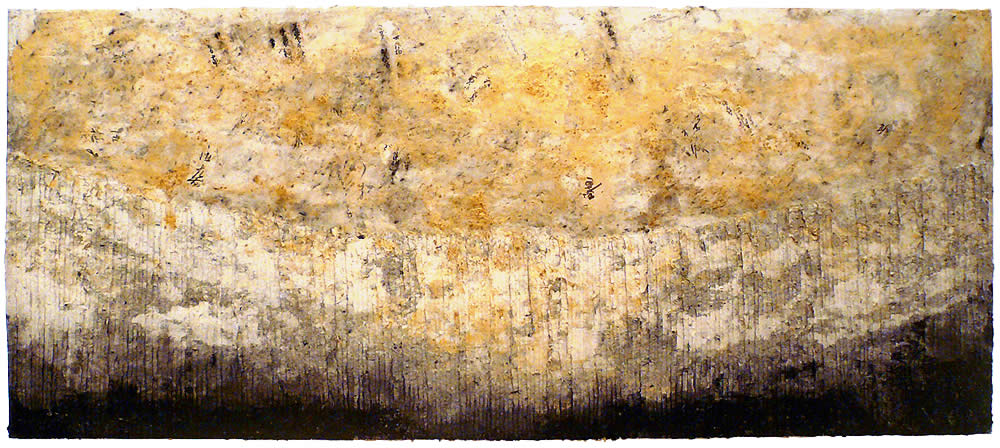Artist's Statement 1 2 3 4 | Exhibition
The World of Yugen: Works of Washi by Kyoko Ibe
Artist’s Statement 2008
Washi, or Japanese handmade paper, has been recognized by western intellectuals through history as the finest handmade paper in the world. For centuries, papermaking techniques that originated in China have thrived in Japan with its mountainous terrain and water-rich resources. Fine quality paper was intrinsic to daily life in Japan’s past, circulating within what has been characterized as a “culture of wood and paper.” Washi’s primary raw materials, fibers extracted from the bark of the kôzo tree (mulberry) and the mitsumata (paper bush) and ganpi shrubs, are collected only once a year in the form of new growth branches, a practice which preserves the root systems of the plants and discourages the over-harvesting of these natural resources. With the exceptions of steam and hydraulic power, washi can otherwise be produced almost entirely by hand, eliminating commercial paper production’s reliance on chemicals and thereby minimizing environmental pollution. In the past both sides of washi were utilized, and if necessary, were reused as the layering material in the construction of traditional sliding doors (fusuma) and folding screens (byôbu) or as a form of wrapping. Torn or damaged paper that could not be used was recycled, resurrected in the form of new washi. Indeed, the wisdom of past generations who lived a life rich in fine paper without destroying their environment stands as a perfect model for a better ecological lifestyle today.
While it is not known precisely when paper recycling began in Japan, the earliest extant record of recycled paper appears in 901A.D in Nihon sandai jitsuroku (Actual Records of the Three Japanese Reigns). The document notes that Fujiwara Tamiko, favored consort of Emperor Seiwa, wrote sutras in memory of Seiwa’s death on paper recycled from his letters to her that she had treasured for their traditional 31-syllable poems (waka). For generations, Fujiwara Tamiko’s recognition of the transience of life through her act of sublimating her sorrow has been revered as a poignant moment in Japanese history.
When washi is recycled, traces of the ink applied to the original surface remain in the fibers even after immersion in water. In medieval times, emperors as well as emperors already retired from rule favored recycled paper for the recording of decrees precisely because of these lingering traces of ink, examples of which are preserved in museums today. People in the past valued the harmony of the myriad shades of gray remaining in the recycled paper, against the pure, unadulterated white of the handmade washi, for their distinctive beauty. The aesthetics of wabi and sabi, delineated by qualities exhibiting austere beauty and elegant rusticity, and wabi-sabi as conjoined expressions are believed to have been perfected later by the venerable tea master Sen no Rikyû (1522-1591) and embody what is considered to be the very richness of the culture of the Heian period (794-1185).
